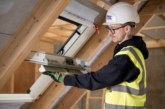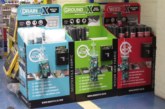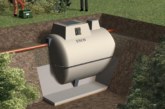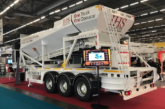
From drinking water and heating, to compressed air and process water systems, multi-layer piping can be used for a wide range of applications. Antony Corbett, Product Manager for Geberit, examines the benefits that press connection technology can have for installers — and the potential sales opportunities it can present for merchants.
Installers have been increasingly turning to press-fit plastic piping over recent years to exploit the benefits that flexible piping can offer. These systems are certainly a versatile option for installers, with its bendable construction and single skin plastic piping offering quick installation times and flame-free jointing.
However, opting instead for a multi-layer piping system can bring together the strength and stability of metal systems, with the flexibility and corrosion resistance of plastic. So, how exactly does the technology work and what are its benefits for installers?
Multi-layer piping systems like Geberit Mepla consist of three layers: an outer plastic layer made of polyethylene (PE-RT of the second generation) which protects against corrosion and mechanical damage, a central aluminium layer which makes the pipe stable yet flexible, plus an inner layer, which is also made of PE-RT, for internal corrosion resistance.
It’s this technology that allows it to be used for all potable water and heating supplies for domestic and light commercial projects, as well as industrial applications such as compressed air and cooling water systems.
Strong and stable
Another advantage that multi-layer systems have over other systems is the improved strength and durability compared to purely plastic piping, without compromising on transportability or weight as is often the case with metals.
The aluminium layer, for example, offers the mechanical stability necessary to ensure that the pipe remains in position whilst also remaining flexible enough to enable it to bend into the required position. This same aluminium also provides the pipe with an oxygen diffusion barrier, making it suitable for central-heating systems and, of course, making it detectable by electronic devices after installation.
The unique construction of multi-layer piping means that installers can have complete ease of mind that the system will not leak. A system from a reputable manufacturer will also have a fail-safe method of checking for unpressed joints.
A multi-layer piping system can be adjusted to suit the application, even manipulated to follow the line of curved architectural features in modern buildings, because of its aluminium layer. Pipes of 16mm and 20mm can be bent by hand to reduce the number of fittings required, which saves time and money during installation. Larger diameters up to 50mm can also be bent without risk of de-lamination or kinking using an appropriate tool.
Even where fittings are required, the option for press fitting enables quick, simple and reliable connections with no need for flames, unlike welding and soldering. This prevents additional mess on site, reduces health and safety considerations and avoids delays to allow for cool down. The only tools needed to form a reliable, tight and durable connection are a cutter, deburrer and press tool.
The absence of a working flame can also reduce insurance premiums and minimises the risk of damage to existing fittings and fixtures and the surrounding areas.
Hygiene and acoustics
There are a number of features which enhance the hygienic qualities of multi-layer piping. Firstly, the polyethylene inner layer is resistant to cracking, ageing and general wear and tear, as well as being non-reactive and corrosion resistant, making it suitable for use in plumbing and potable-water applications.
The low internal surface roughness (7 µm) of the inner layer also means it is more difficult for limescale and biofilm to adhere to the smooth surface, providing resistance to scale build-up.
It has excellent acoustic insulation properties, so water passing through the pipework produces less noise than in metal piping. Fittings and pipes from leading manufacturers even come with protective caps for added hygienic safety when stored or during an installation break.
Reliability
These benefits wouldn’t matter in the slightest if the piping was not reliable, but thanks to the construction of multi-layer piping, contractors and end users can have confidence in the leak-proof system.
With Geberit Mepla, there is a fail-safe method of checking for unpressed joints. Unpressed fittings are designed to leak slightly during pressure testing (even at low water testing pressure) and can be pressed without having to drain down the entire system.
A solution for all applications, multi-layer piping is a great all-rounder to stock. It is a great choice for contractors working on light commercial and industrial projects and leading manufacturers now offer pipes in a broad range of diameters to enable crucial consistency across larger construction projects, including new schools, hospitals and offices.
Multi-layer piping is versatile and economical – which makes it the perfect choice for a wide range of applications outside of plumbing and potable water. Multi-layer piping offers high margin opportunities when working across a range of sectors including automotive, chemical, pharmaceutical and food processing, for compressed air, vacuum systems, cooling equipment and process water systems.









